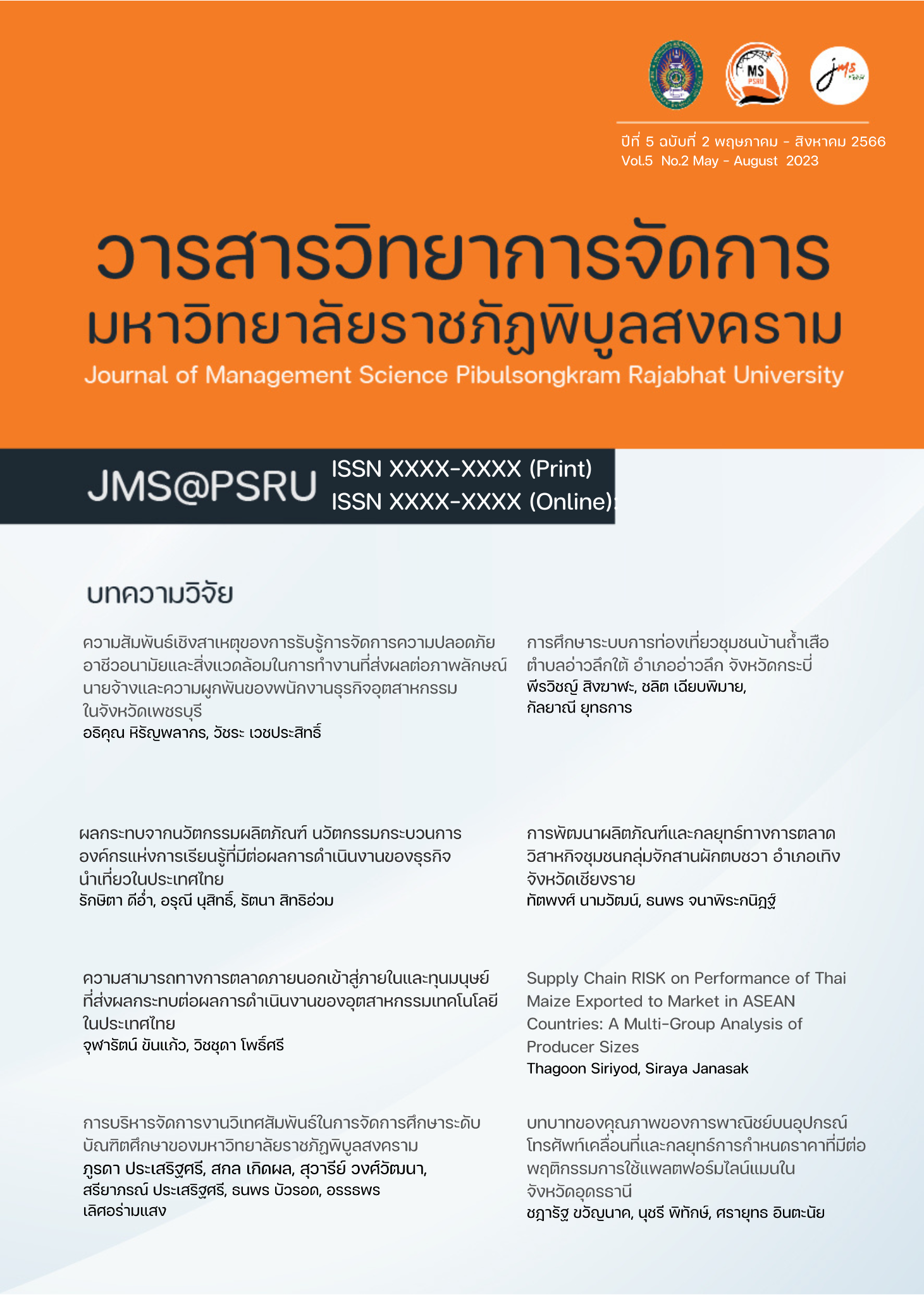Supply Chain RISK on Performance of Thai Maize Exported to Market in ASEAN Countries: A Multi-Group Analysis of Producer Sizes
คำสำคัญ:
ASEAN, Thai maize, Supply chain risks, Supply chain performance, PLS-MGAบทคัดย่อ
The study aims to determine and construct supply chain risks and supply chain performance of the Thai maize supply chain exported to ASEAN markets, and examine the effect of the risks in the supply chain and the supply chain performance together with the sizes of producers as moderate variables. A total of 228 questionnaires were distributed to 203 small producers and 25 medium and large Thai maize producers exporting maize to ASEAN markets. PLS-SEM algorithm and PLS-MGA were used to analyze the data by SmartPLS 4. The findings showed that storage risks, labour risks, supply-side risks, governmental and policy risks, and information flow risks significantly affected supply chain performance. Moreover, according to PLS-MGA, information flow risks significantly affected supply chain performance among groups.
เอกสารอ้างอิง
Aramyan, L. H., Lansink, A. O., Van der Vorst, J., & Vankooten, O. (2007). Performance measurement in agri-food supply chains: A case study. International Journal of Supply Chain Management, 12(4), 304-315.
Becker, J. M., Rai, A., Ringle, C. M., & Völckner, F. (2013). Discovering unobserved heterogeneity in structural equation models to avert validity threats. MIS Quarterly, 37(3), 665–694.
Chan, F. T. S. (2003). Performance measurement in a supply chain. International Journal of Advanced Manufacturing Technology, 21(7), 534–548.
Chin, W. W. (1998). The partial least squares approach to structural equation modeling. Modern methods for business research, 295(2), 295-336.
De Juana-Espinosa, S., & Rakowska, A. (2018). Public sector motivational practices and their effect on job satisfaction: Country differences. European Journal of Management and Business Economics, 27(2), 141–154.
Durst, S., & Edvardsson, I. R. (2012). Knowledge management in SMEs: A literature review. Journal of Knowledge Management, 16(6), 879-903.
Hendricks, K. B., & Singhal, V. R. (2005). Association Between Supply Chain Glitches and Operating Performance. Management Science, 51(5), 695-711.
Henseler, J., Hubona, G., & Ray, P. A. (2016). Using PLS path modeling in new technology research: Updated guidelines. Industrial Management and Data Systems, 116(1), 2–20.
Ho, W., Zheng, T., Yildiz, H., & Talluri, S. (2015). Supply chain risk management: a literature review. International Journal of Production Research, 53(16), 5031-5069.
Hosseini, M. R., Banihashemi, S., Chileshe, N., Namzadi, M. O., Udaeja, C., Rameezdeen, R., & McCuen, T. (2016). BIM adoption within Australian small and medium-sized enterprises (SMEs): An innovation diffusion model. Construction Economics and Building, 16(3), 71–86.
International Trade Centre. (2022). List of importers for the selected productt: 100590 Maize (excluding seed for sowing). Retrieved February 20, 2022, from https://www.trademap.org/tradestat/Country_SelProduct_TS.aspx?nvpm
Jaffee, S., Siegel, P., & Andrews, C. (2010). Rapid agricultural supply chain risk assessment: a conceptual framework. Washington. D.C: The World Bank.
Kern, D., Moser, R., Hartmann, E., & Moder, M. (2012). Supply risk management: Model development and empirical analysis. International Journal of Physical Distribution & Logistics Management, 42(1), 60-82.
Li, S., Ragu-Nathan, B., Ragu-Nathan, T., & Rao, S. S. (2006). The impact of supply chain management practices on competitive advantage and organizational performance. Omega, 34(2), 107-124.
Rathore, R., Thakkar, J. J., & Jha, J. K. (2017). A quantitative risk assessment methodology & evaluation of food supply chain. International Journal of Logistics Management, 28(4), 1272–1293.
Rosenau, M. D., Griffin, A., Castellion, G. A., & Anschuetz, N. F. (1996). The PDMA Handbook of New Product Development. New York: Wiley.
Sheffi, Y., & Rice Jr, J. B. (2005). A supply chain view of the resilient enterprise. MIT Sloan Management Review, 47(1), 41–48.
Singh, R. K., Garg, S. K., & Deshmukh, S. G. (2008). Implementation of information technology: Evidences from Indian SMEs. International Journal of Enterprise Network Management, 2(3), 248-267.
Sitkin, S. B., & Pablo, B. L. (1992). Reconceptualizing the determinants of risk behaviour. Academy of Management Review, 17(1), 9-38.
SME Development Bank of Thailand. (2008). Regional Finance in Recent Period and the Way Forward. Retrieved March 15, 2022, from http://goo.gl/a8nlG
Son, B. G., Ha, B. C., & Lee, T. H. (2019). Small and Medium-Sized Enterprises’ Collaborative Buyer–Supplier Relationships: Boundary Spanning Individual Perspectives. Journal of Small Business Management, 57(3), 966–988.
Sreedevi, R., & Saranga, H. (2017). Uncertainty and supply chain risk: The moderating role of supply chain flexibility in risk mitigation. International Journal of Production Economics, 193, 332–342.
Valaei, N., & Nikhashemi, S. R. (2017). Generation Y consumers’ buying behaviour in fashion apparel industry: a moderation analysis. Journal of Fashion Marketing and Management: An International Journal, 21(4), 523–543.
Wagner, S.M., & Bode, C. (2008). An empirical examination of supply chain performance along several dimensions of risk. Journal of Business Logistics, 29(1), 307-325.
Welker, G. A., Van Der Vaart, T., & Van Donk, D. P. (2008). The influence of business conditions on supply chain information sharing mechanisms: A study among supply chain links of SMEs. International Journal of Production Economics, 113(2), 706–720.
World Bank Group. (2022). GDP growth (annual). Retrieved February 6, 2022, from https://data.worldbank.org/indicator/NY.GDP.MKTP.KD.ZG
Yeboah, N. E., Feng, Y., Daniel, O. S., & Joseph, N. B. (2014). Agricultural supply chain risk identification- a case finding from Ghana. Journal of Management and Strategy, 5(2), 31-48.
ดาวน์โหลด
เผยแพร่แล้ว
รูปแบบการอ้างอิง
ฉบับ
ประเภทบทความ
สัญญาอนุญาต
ลิขสิทธิ์ (c) 2023 มหาวิทยาลัยราชภัฎพิบูลสงคราม

อนุญาตภายใต้เงื่อนไข Creative Commons Attribution-NonCommercial-NoDerivatives 4.0 International License.
บทความที่ได้รับการตีพิมพ์ในวารสารวิทยาการจัดการมหาวิทยาลัยราชภัฏพิบูลสงคราม เป็นลิขสิทธิ์ของ คณะวิทยาการจัดการ มหาวิทยาลัยราชภัฎพิบูลสงคราม บทความที่ลงพิมพ์ใน วารสารวิทยาการจัดการมหาวิทยาลัยราชภัฎพิบูลสงคราม ถือว่าเป็นความเห็นส่วนตัวของผู้เขียน คณะบรรณาธิการไม่จำเป็นต้องเห็นด้วย ผู้เขียนต้องรับผิดชอบต่อบทความของตนเอง



